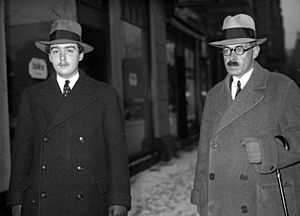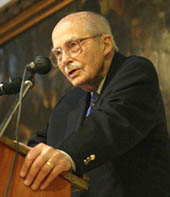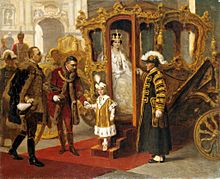Otto von Habsburg facts for kids
Quick facts for kids
Otto Von Habsburg
|
|
|---|---|
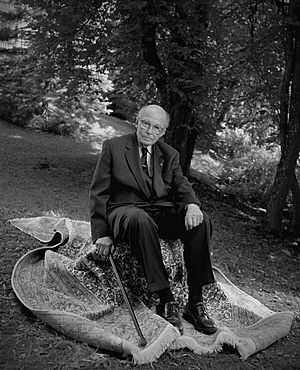
2006 portrait by Oliver Mark
|
|
| Member of the European Parliament for Germany | |
| In office 1979–1999 |
|
| Head of the House of Habsburg-Lorraine | |
| In office 1 April 1922 – 1 January 2007 |
|
| Preceded by | Emperor Charles I |
| Succeeded by | Karl von Habsburg |
| Personal details | |
| Born | 20 November 1912 Wartholz Castle, Reichenau an der Rax, Lower Austria, Austria-Hungary |
| Died | 4 July 2011 (aged 98) Pöcking, Bavaria, Germany |
| Resting place | Imperial Crypt (body); Pannonhalma Archabbey (heart) |
| Nationality |
|
| Political party | Christian Social Union |
| Spouse |
Princess Regina of Saxe-Meiningen
(m. 1951; died 2010) |
| Children |
|
| Parents | Charles I of Austria Zita of Bourbon-Parma |
| Signature |  |
Otto von Habsburg (born 20 November 1912 – died 4 July 2011) was a very important person in European history. He was the last crown prince of Austria-Hungary. This means he was next in line to be emperor and king. He held this title from 1916 until the empire broke apart in 1918.
After his father died in 1922, Otto became the leader of the House of Habsburg-Lorraine. This was the royal family that used to rule Austria-Hungary. He also became the head of a special group called the Order of the Golden Fleece. He later stepped down from these roles in 2000 and 2007.
Otto was the oldest son of Charles I and IV, who was the last emperor of Austria and king of Hungary. His mother was Zita of Bourbon-Parma. Otto was born as a prince and was third in line to the throne. When his father became emperor in 1916, Otto was expected to become the next ruler. Since his father never officially gave up his title, Otto and his family believed he was the rightful emperor and king after his father's death.
Otto became active in politics in Austria and Europe in the 1930s. He wanted to bring back the Habsburg royal family. He also strongly supported the idea of European integration, which means European countries working closely together. He disliked nationalism, which is when people think their own country is much better than others. He was also a strong opponent of Nazism and communism. He was even called one of the leaders of the Austrian Resistance against the Nazis. After Germany took over Austria in 1938, the Nazis sentenced him to death, and he had to flee to the United States.
Otto von Habsburg was a leader in the International Paneuropean Union movement. He was Vice President from 1957 to 1973 and President from 1973 to 2004. From 1979 to 1999, he was a Member of the European Parliament for Germany. He cared a lot about countries behind the Iron Curtain (Communist countries). He even put an empty chair in the European Parliament to show they were missing. Otto helped organize the Pan-European Picnic in 1989. This event was very important in the fall of Communist governments in Europe. He strongly supported central and eastern European countries joining the European Union. He wrote many books about history and politics. People often call Otto one of the "architects of the European idea" because he helped shape European cooperation.
Otto was forced to leave Austria in 1919 and grew up mostly in Spain. His mother, who was very religious, taught him to be a good Catholic ruler. During his time away from home, he lived in many countries like Switzerland, Madeira, Spain, Belgium, France, and the United States. From 1954 until he died, he lived in Germany. When he died, he was a citizen of Germany, Austria, Hungary, and Croatia. He also had passports from the Order of Malta and Spain.
His funeral was held at St. Stephen's Cathedral in Vienna on 16 July 2011. His body was buried in the Imperial Crypt in Vienna, and his heart was buried in Pannonhalma Archabbey in Hungary.
Contents
Early Life and Royal Heritage

Otto was born at Villa Wartholz in Reichenau an der Rax, Austria-Hungary, on 20 November 1912. This was during the rule of his great-grand uncle, Franz Joseph I of Austria. He was given a very long name: Franz Joseph Otto Robert Maria Anton Karl Max Heinrich Sixtus Xaver Felix Renatus Ludwig Gaetan Pius Ignatius. This name was chosen so he could one day rule as "Franz Joseph II." His godfather was Emperor Franz Joseph I.
In November 1916, Otto became the Crown Prince of Austria, Hungary, Bohemia, and Croatia. This happened when his father, Archduke Charles, became the new ruler. However, in 1918, after World War I ended, the monarchies were abolished. New republics were formed in Austria and Hungary, and Otto's family had to leave their home. They went to live in exile on the island of Madeira. Hungary later became a kingdom again, but Charles never got his throne back. Instead, Miklós Horthy ruled as a regent, meaning he governed a kingdom that had no king.
Otto was very good at languages. He spoke German, Hungarian, Croatian, English, Spanish, French, and Latin fluently. His mother made sure he learned many languages because she believed he might one day rule over many different lands. Later in his life, he wrote about forty books in German, Hungarian, French, and Spanish.
Life in Exile and Education
Otto's family spent many years living outside their home country. They lived in Switzerland and on the Portuguese island of Madeira. Otto's father, Charles, died in Madeira in 1922 when Otto was only nine years old. After his father's death, Otto became the "pretender" to the throne. This meant he was the person who would have been king if the monarchy still existed. His mother, Empress Zita, told him on his father's deathbed, "Your father is now sleeping the eternal sleep—you are now Emperor and King."
The family later moved to a town in Spain called Lekeitio. Forty important Spanish nobles bought them a villa there. Meanwhile, the Austrian parliament had passed a law called the Habsburg Law in 1919. This law officially removed the Habsburg royal family from power and took away all their official property. Charles was not allowed to return to Austria. Otto and other male family members could only come back if they gave up all their claims to the throne and agreed to live as regular citizens.
In 1935, Otto earned a PhD degree in Political and Social Sciences from the University of Louvain in Belgium. He was 23 years old at the time. His studies focused on the laws about land ownership in Austria.
Otto continued to have a lot of support from people in Austria. From 1931 to 1938, over 1,600 Austrian towns made Otto an honorary citizen. However, some people thought that if Otto returned, his mother and many other Habsburg relatives would also come back. This was seen as a problem. A bigger challenge was that Czechoslovakia and Yugoslavia did not want the monarchy to return. They worried their own people might want to rejoin a recreated empire.
Otto's Role in World War II
Otto strongly opposed the Anschluss, which was when Nazi Germany took over Austria in 1938. He asked the Austrian leader, Kurt Schuschnigg, to fight against Nazi Germany. Otto even offered to return from exile to lead the government and stop the Nazis. Many Austrian Jews supported the idea of bringing back the Habsburg family. They believed the royal family would help Austria resist the Nazis.
After Germany annexed Austria, the Nazi regime sentenced Otto to death. Rudolf Hess, a high-ranking Nazi, ordered that Otto should be killed immediately if he was caught. Adolf Hitler personally ordered that Otto's property and all the property of the House of Habsburg be taken away. This property was never returned after the war. The "Habsburg Law" was brought back by the Nazis. Otto's supporters, who wanted the monarchy restored, were arrested by the Nazis. Many of them were executed. Otto's cousins, Max and Prince Ernst of Hohenberg, were arrested and sent to the Dachau concentration camp. They stayed there throughout the Nazi rule. Otto helped about 15,000 Austrians, including thousands of Jewish people, escape the country at the start of World War II.
When Germany invaded France in 1940, Otto's family fled to Portugal. The Portuguese leader, António Salazar, helped them get passports so they could travel safely. When Germany tried to get Portugal to hand over Otto, Salazar protected him but asked him to leave the country for his own safety. Otto then lived in Washington, D.C. from 1940 to 1944. In 1941, Hitler took away the citizenship of Otto, his mother, and his siblings. This made the imperial family stateless.
Otto was on a special Nazi list for people to be hunted down in Great Britain. He was also the unofficial leader of many resistance groups in Central Europe. These groups hated Nazi ideas. They believed that a "Danube confederation" (a group of small states working together) was the only way for these countries to survive between Germany and Russia. They supported the old Habsburg idea of "live and let live" among different ethnic groups, religions, and cultures. These resistance groups fought fiercely against Hitler. Many of these fighters were sent to concentration camps without a trial. Over 800 were executed by the Nazis.
During his time in the United States, Otto and his younger brothers spoke directly with President Franklin D. Roosevelt. Otto tried to create an "Austrian Battalion" in the United States Army, but this never happened. However, he successfully convinced the U.S. to limit the bombing of Austrian cities, especially Vienna. Because of his influence, bombings on Vienna were delayed until 1943. Otto wanted Austria to be free, independent, and democratic. He worried that after the war, Austria might become a Soviet satellite state (controlled by the Soviet Union). Otto was known in the U.S. as "Otto of Austria." He tried to keep his homeland in the minds of Americans by helping to create a series of stamps featuring the German-occupied nations of Europe.
He gained the support of Winston Churchill for a "Danube Federation," which was like bringing back Austria-Hungary. But Joseph Stalin stopped these plans. Otto also pushed for an Austrian government-in-exile to be recognized. He supported the rights of German-speaking people in South Tyrol and opposed the forced removal of German-speaking people from Bohemia and Eastern Europe. He also argued against letting Stalin control Eastern Europe.
Life After World War II
After the war ended, Otto returned to Europe. He lived for several years in France and Spain. Since he had no passport and was effectively stateless, he was given a passport from Monaco in 1946. This happened thanks to Charles de Gaulle. The Sovereign Military Order of Malta, a group he belonged to, also gave him a diplomatic passport. Later, he received a Spanish diplomatic passport as well.
On 8 May 1956, Otto was recognized as an Austrian citizen. The Austrian government approved this, but only if he accepted the name Dr. Otto Habsburg-Lothringen. However, this passport was "valid in every country but Austria." Otto had already stated in 1958 that he and his family would give up all their old royal privileges. But this was not enough for the Habsburg Law. This law said that Otto and other descendants of Charles could only return to Austria if they gave up all claims to the throne and became private citizens. He officially declared his loyalty to the Republic of Austria on 5 June 1961, but this statement was also not enough.
On 31 May 1961, Otto officially gave up all claims to the Austrian throne. He said he was "a loyal citizen of the republic" for "practical reasons." The Austrian court decided on 24 May 1963 that Otto's statement was legally enough. He and his wife were given proof of citizenship on 20 July 1965. However, some political groups in Austria, especially the Socialists, did not want the heir of the old royal family to return. This caused political arguments and unrest, which became known as the "Habsburg Crisis."
Finally, on 1 June 1966, after a new election, Otto was given an Austrian passport. He was able to visit his home country again on 31 October 1966, for the first time in 48 years. He traveled to Innsbruck to visit a grave. Later, he visited Vienna on 5 July 1967.
Political Career and European Vision
Otto was an early supporter of a unified Europe. He was the president of the International Paneuropean Union from 1973 to 2004. From 1979 to 1999, he served as a Member of the European Parliament for the conservative Christian Social Union of Bavaria (CSU) party. He became a very senior member of the European Parliament. He strongly supported the expansion of the European Union, especially for Hungary, Slovenia, and Croatia.
During his time in the European Parliament, he had a famous argument with another member, Ian Paisley. In 1988, Pope John Paul II was giving a speech to the Parliament. Ian Paisley, who was strongly against Catholics, shouted and held up a poster. Otto quickly grabbed Paisley's banner and, with others, removed him from the room.
Otto was also very important in organizing the Pan-European Picnic on the Hungary-Austria border on 19 August 1989. This event is seen as a key moment in the fall of Communist governments in Europe.
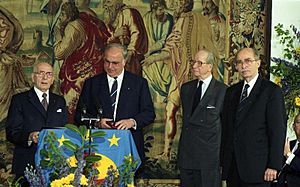
In 2006, he talked about the September 11 attacks. He said that the attacks made Americans understand the risks they faced in a new way. Otto was known for supporting the rights of refugees and displaced people in Europe. He was also a judge for the Franz Werfel Human Rights Award. He respected Francisco Franco, a Spanish leader, for helping refugees.
In 2002, he was made the first honorary member of the European People's Party group. Otto von Habsburg was also an early critic of Russian President Putin. In speeches and interviews, he warned that Putin was an "international threat" and "cruel and oppressive."
On the anniversary of the Anschluss in 2008, Otto said that "no country in Europe has a better claim to be a victim of the Nazis than Austria." This caused some public debate and criticism from Austrian politicians. However, others defended his statement, pointing out the many Austrians who resisted the Nazis.
Death and Funeral
After his wife, Regina, died in 2010, Otto stopped appearing in public. He passed away peacefully in his sleep at his home in Pöcking, Germany, on 4 July 2011, at the age of 98. His body was placed in the Church of St. Ulrich near his home. Many countries that were once part of Austria-Hungary had a 13-day period of mourning.
Otto's coffin was covered with the Habsburg flag, which had the royal symbols of Austria and Hungary. Following a special Habsburg family tradition, Otto von Habsburg was buried in the family's crypt, called the Imperial Crypt, in Vienna. His heart was buried separately in Pannonhalma Archabbey in Hungary.
Family Life
Otto married Princess Regina of Saxe-Meiningen in 1951 in Nancy, France. His mother, Empress Zita, attended the wedding. They celebrated their 50th wedding anniversary there in 2001. Otto lived in retirement at the Villa Austria in Pöcking, Germany.
When he died in 2011, Otto and Regina had seven children, 22 grandchildren, and two great-grandchildren. Their children are:
- Andrea von Habsburg (born 1953)
- Monika von Habsburg (born 1954)
- Michaela von Habsburg (born 1954, Monika's twin)
- Gabriela von Habsburg (born 1956)
- Walburga von Habsburg (born 1958)
- Karl von Habsburg (born 1961)
- Georg von Habsburg (born 1964)
Official Titles and Honors
| Styles of Crown Prince Otto of Austria |
|
|---|---|
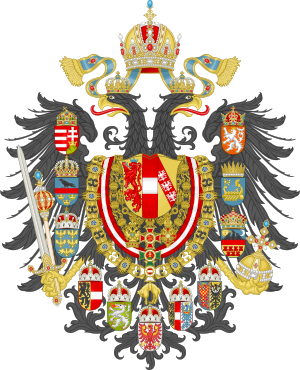 |
|
| Reference style | His Imperial and Royal Highness |
| Spoken style | Your Imperial and Royal Highness |
Otto held many titles throughout his life, reflecting his royal heritage and his later citizenship in different countries.
- From 1912 to 1916: His Imperial and Royal Highness Archduke and Prince Otto of Austria, Prince of Hungary, Bohemia, Dalmatia, Croatia and Slavonia.
- From 1916 to 2011: His Imperial and Royal Highness The Crown Prince of Austria, Hungary, Bohemia and Croatia.
After the monarchy ended, he was officially known in different countries:
- In Austria (from 1957): Herr Doktor Otto Habsburg-Lothringen.
- In Croatia (from 1990): Archduke Otto von Habsburg.
- In Germany (from 1978): Otto von Habsburg.
He received many honors and awards from various countries and organizations for his work and contributions. Some of these include:
- Knight of the Order of the Golden Fleece (Austria-Hungary)
- Grand Cross of the Grand Order of King Dmitar Zvonimir (Croatia)
- Grand Cross of the Legion of Honour (France)
- Grand Cross of the Order of Merit of the Federal Republic of Germany (Germany)
- Grand Cross of the Order of Merit of the Republic of Hungary (Hungary)
- Knight Grand Cross of the Order of Charles III (Spain)
- Bailiff Knight Grand Cross of the Sovereign Military Order of Malta
He also received many academic awards and honorary doctorates from universities around the world, recognizing his intellectual contributions.
Images for kids
See also
 In Spanish: Otón de Habsburgo-Lorena para niños
In Spanish: Otón de Habsburgo-Lorena para niños


